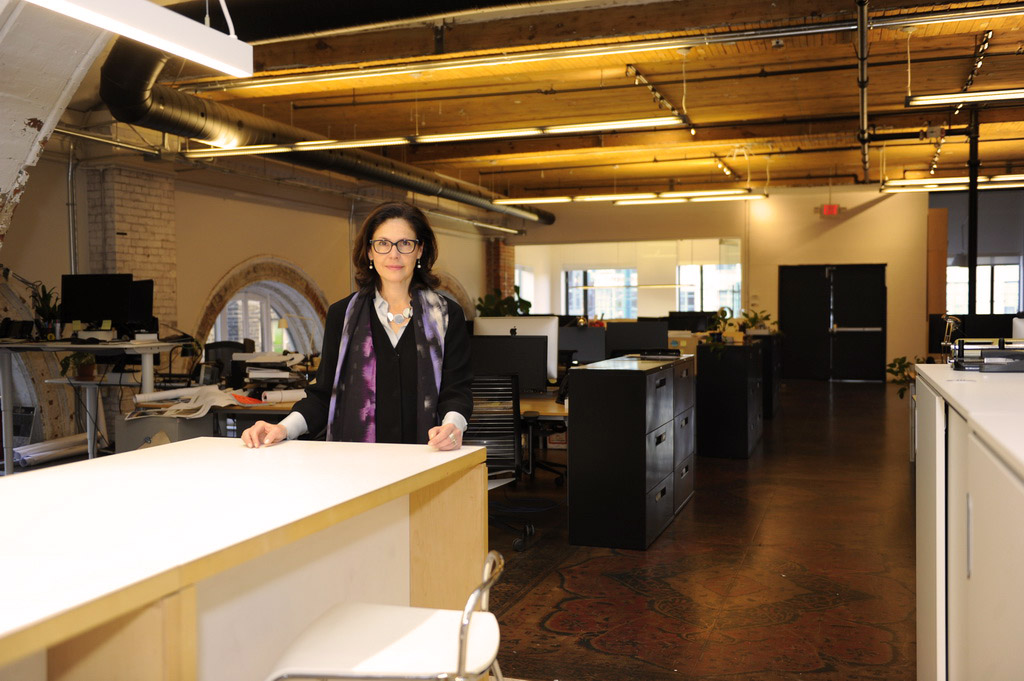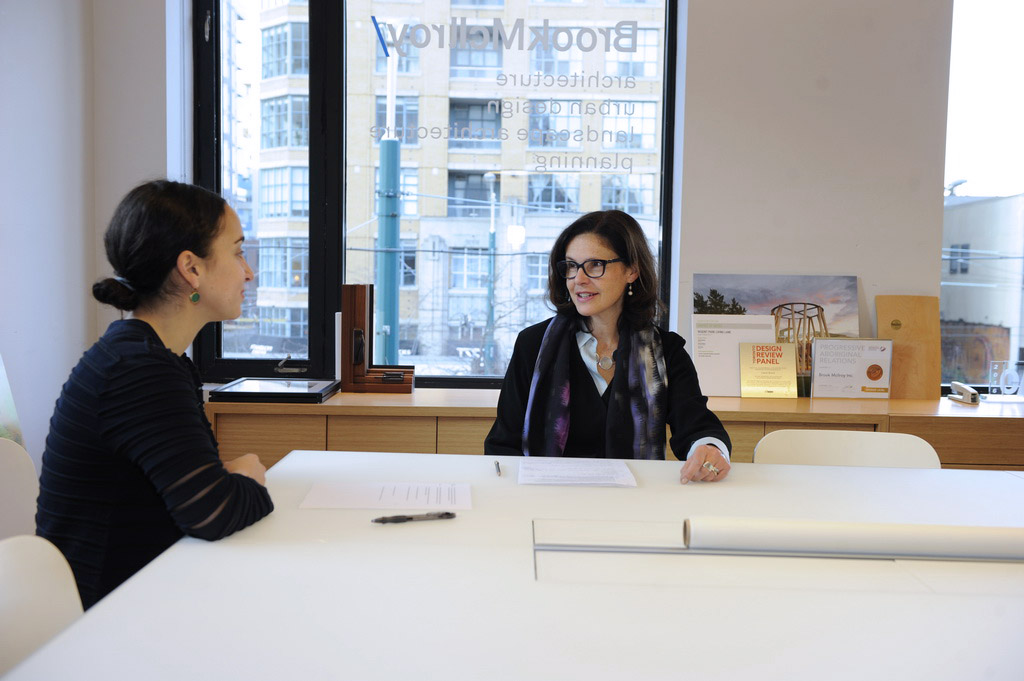Anne McIlroy
“The ability to do development in a relationship to a planned open space whether it be a park, a new bridge, a courtyard, even a garden is so important in the City so that as we intensify, we build with it more open space and green space. As we live up in the air, we need to have access to these spaces down below.”
Anne McIlroy
Mansouri Living sits down with Planner Anne McIlroy in their striking office space to discuss her work and thoughts on planning and the vibrant growth of Toronto. Anne is a Principal of Brook McIlroy. She graduated from the University of Toronto with a Bachelor of Fine Arts and a Bachelor of Architecture in 1987 and has over twenty five years of experience as an Urban Designer for master plan projects across Canada and the United States. Anne has been appointed to the Toronto Community Housing Design Review Panel and to the National Capital Commission’s Design Review Panel.

What are your urban planning philosophies, what’s important to a city?
I think the best cities grow organically and incrementally, cities reflect people. Human flourishing is best when it's done in a way that our spirit is excited and we do what we enjoy. As soon as we’re moved into a rigid framework of living, it's not the best way to evolve and live our lives. We have to both grow organically and have structure.
If an architect is faced with guidelines that are so restrictive that they actually can't be creative, it’s prohibitive to the creation of beauty in our City. So over-control is not a good thing. It's hard to find that when you think of big cities like the City of Toronto, the Planning Department and Urban Design Department. These bodies are under such duress to process things and to take them through the formal channels like consulting with the engineering department, and fire safety, and making sure that everything works, and is safe and accessible – essentially the nuts and bolts of requirements that have to be done. At the end of the day, there's probably not a lot of time to really consider the beauty of a project.
So that's a challenge and I think the more we talk about it—design review panels have actually created a great opening into that dialogue as they gather the range of professionals that should be involved like Architects, Urban Planners, Urban Designers, Landscape Architects, and Engineers to comment on projects. Since its advisory, the City can take the commentary as advice, and typically they do because the advice is often very, very comprehensive and good, and I think it often gives them the strength and the back-up to make certain decisions that they couldn't necessarily have come to had they not had that room of decision-makers, beyond the numbers and codes.

What would you like to see more of in Toronto?
I would like to see more tall buildings and intensive development consider public open space an amenity that is for the public as a whole. And that goes to the streets that the buildings face, to the courtyards and gardens that they should integrate, and the contributions that they make to parks that exist already. I'd love to see more bridges in the city. We won't ever be a Canal City, but I think that we could be a city of more bridges to get over the rail corridors, the ravines and places that we could have greater access to. I mean, the ravines in Toronto are very special places that not very many people know about. They are for many a bit of a hidden story and I think getting into the ravines and getting over them, having views of them through more bridges and ways that reflect those beautiful little arteries that run through the city like ribbons would be pretty nice.
What’s your favorite street in Toronto, where do you like to go for walks?
I love St. George Street.
I was at U of T for eight years, first in fine art, and then in architecture.
I spent a lot of time walking up and down St. George Street when it wasn't a very nice street. And it was a real traffic sewer down in the middle of the campus that divided east and west sides. Then it was transformed by Judy Matthews, who is the person that's funded the Underpass Park, near Bathurst Street. She and her husband Wilmont Matthews gave the first $1 million about 20 years ago which was matched by the City. And the street, although looking a little bit aged now, is still utterly transformed from what it was. And because it's got those crossing areas for students, they feel like they've got the right-of-way to cross the street.
And Willcocks Street is now closed which is creating a connection into St George Street, a pedestrian only street. It's a place where they put up tables and chairs, like that little section of Broadway in New York where you can sit out in a place where you would expect cars to be driving through but is rather protected by planters.
And where do I like to go for walks? Well, you know what I like to do? I like to get up every morning and go for a little run. And I go two places. I go into the Cedar Hill Ravine which makes me feel like I'm in the country. And there's sections of it where you don't even see a building. I used to run there with our dog and she loved it too. And then when I have less time, I go across through Yorkville. So I weave my way through Yorkville over to Yonge Street, and that's my run in the morning. And sometimes I even shop when I run [laughter]. I stop at that little Pusateri’s and I pick up a few things and jog home with them.

The Annex has undergone extensive transformation and continues to do so. Looking back 10 years ago to what it is today, where have you seen improvements and the most change?
The greatest changes in The Annex have been happening on the edges of it, and that's Avenue road, Davenport, Dupont, and parts of Bloor Street and Bathurst. The least activity is happening in the middle of it, where the neighborhoods are, which is great. I think it's such a wonderful neighborhood because it has little parks, tree lined streets, and it's a great example of a neighborhood in Toronto. I think when people come to Toronto from other cities they really say they love our neighborhoods because they're very distinct and they have the main streets that align them. The least change I think has happened on Bathurst Street, which is the kind of a sleeper street that will change in time with the Mirvish development, I think that's going to trigger change up and down that street.
And then certainly Dupont has been slow to move, but it is now finally coming up, especially in areas where there are blocks of wider space in front of the railway, so there will be opportunity for more mid-rise, and, maybe in some key locations even taller buildings, particularly because the shadow impacts are to the north and across the rail corridor. So there's that buffer that works well.
Davenport, of course, is going to change. It's been very incrementally, slowly coming along and I think as it moves towards Avenue Road we're going to see a lot of those parcels grow. If we can get the development heights to be reasonable along those edges, I think it will result in a much more vibrant neighborhood, and better use of transit, and the many subway locations that are near, like the entrance of Walmer, the entrance at Kendal, the Spadina Bloor entrance, and then we have another subway right at Dupont. Also people that live closer to Avenue Road have all the benefit of living adjacent to the Yorkville neighborhood.
Yorkville's a really interesting topic. Because up until about only 10 years ago, store owners in Yorkville were barely making ends meet and I know that because we did the guidelines for Yorkville for 2003. And we interviewed many, many businesses there about how things were going and they said, "We need intensification in Yorkville because the shops are not doing very well." And that the land values were going up so for people to buy a shop, and run a business was just getting more and more difficult. And there are all those subways there as well.
And how do you see all the change that Yorkville is going through now?
I think it's pretty good. I think doing the Cumberland Park was a great idea, so to have that open block in the heart of it. I think the ability to do development in a relationship to a planned open space whether it be a park, a new bridge, a courtyard, even a garden is so important in the city so that as we intensify, we build with it more open space and green space. As we live up in the air, we need to have access to these spaces down below.
That was a great move on part of the local residents, the BIA to plan that park and execute it because it does create that kind of heart of the area, the meeting space, the place to do special events. They do their ice sculptures in there. They do the car events on Cumberland happening where they have all the fancy cars [laughter]. The Rock is an iconic location. Every kid in the city knows about the Rock and, if anybody saw that rock in advance of it being there, they would have thought people would be dying on the rock [laughter] but nobody so far has died on the rock [laughter].
Do you look to other cities for reference, or parts of other cities?
I love London. I was born in London. But I only lived there for three years. As a student when I was studying architecture, I went back and worked for architects in London. And so I know the city because I biked everywhere as my means of transportation, and I worked in a variety of different places in different ends of the city. I love going back there. It's just one of my most favorite cities because the park system that weaves through the whole of the city. When you're out of the major Hyde Park, Green Park, Kensington Gardens chain of parks, then you get into these beautiful urban squares. St James Square, and Bedford Square, and Russell Square, Queen Square and many of them interconnect with beautiful streets in between. The experience of walking through London any day, any time of year is something that I enjoy and I just feel this is really living in an urban environment that has history and new contemporary buildings in places where they belong that start to become iconic silhouettes on the landscape. They've all got names - the Gherkin, the Toaster, the Shard [laughter].

